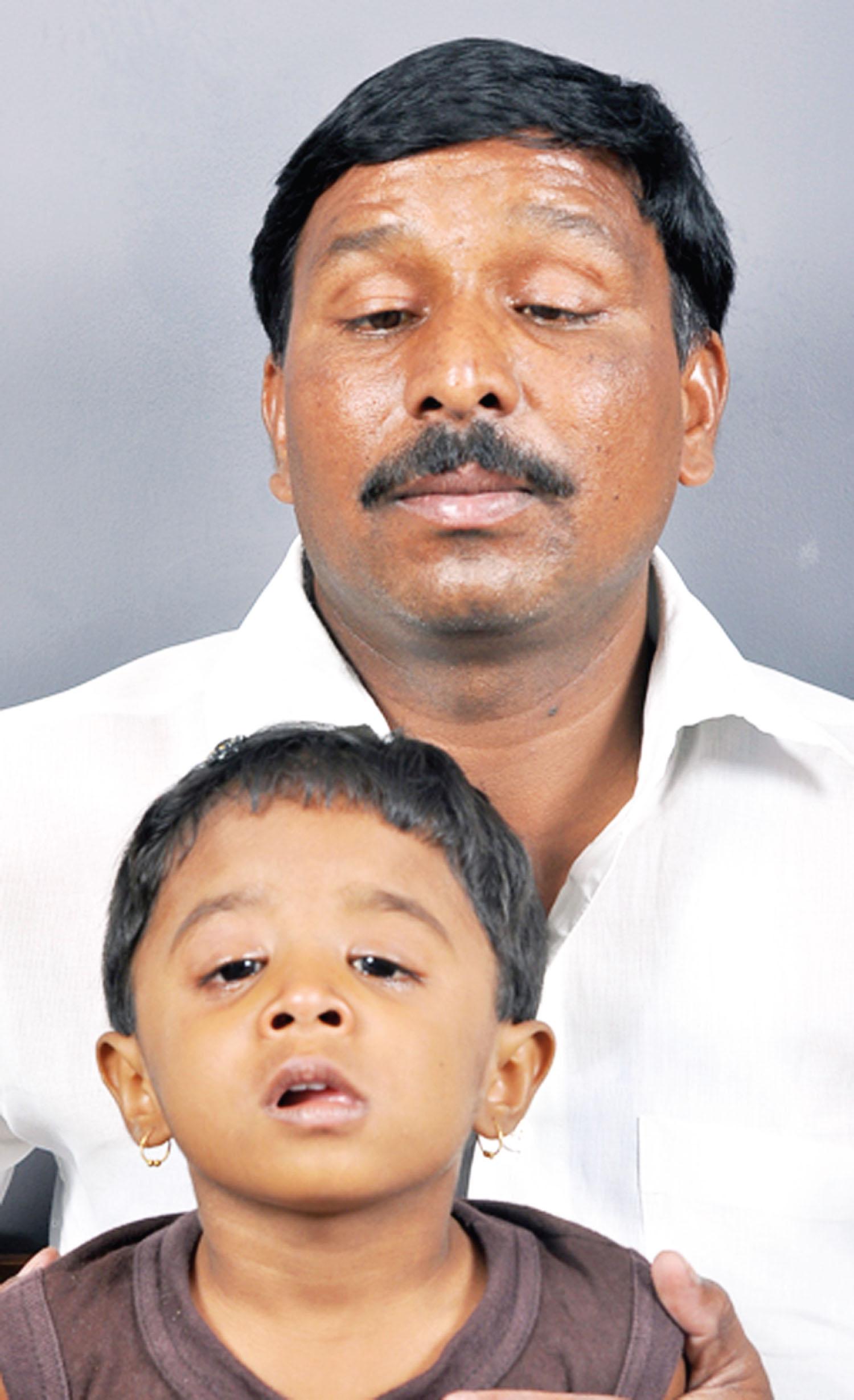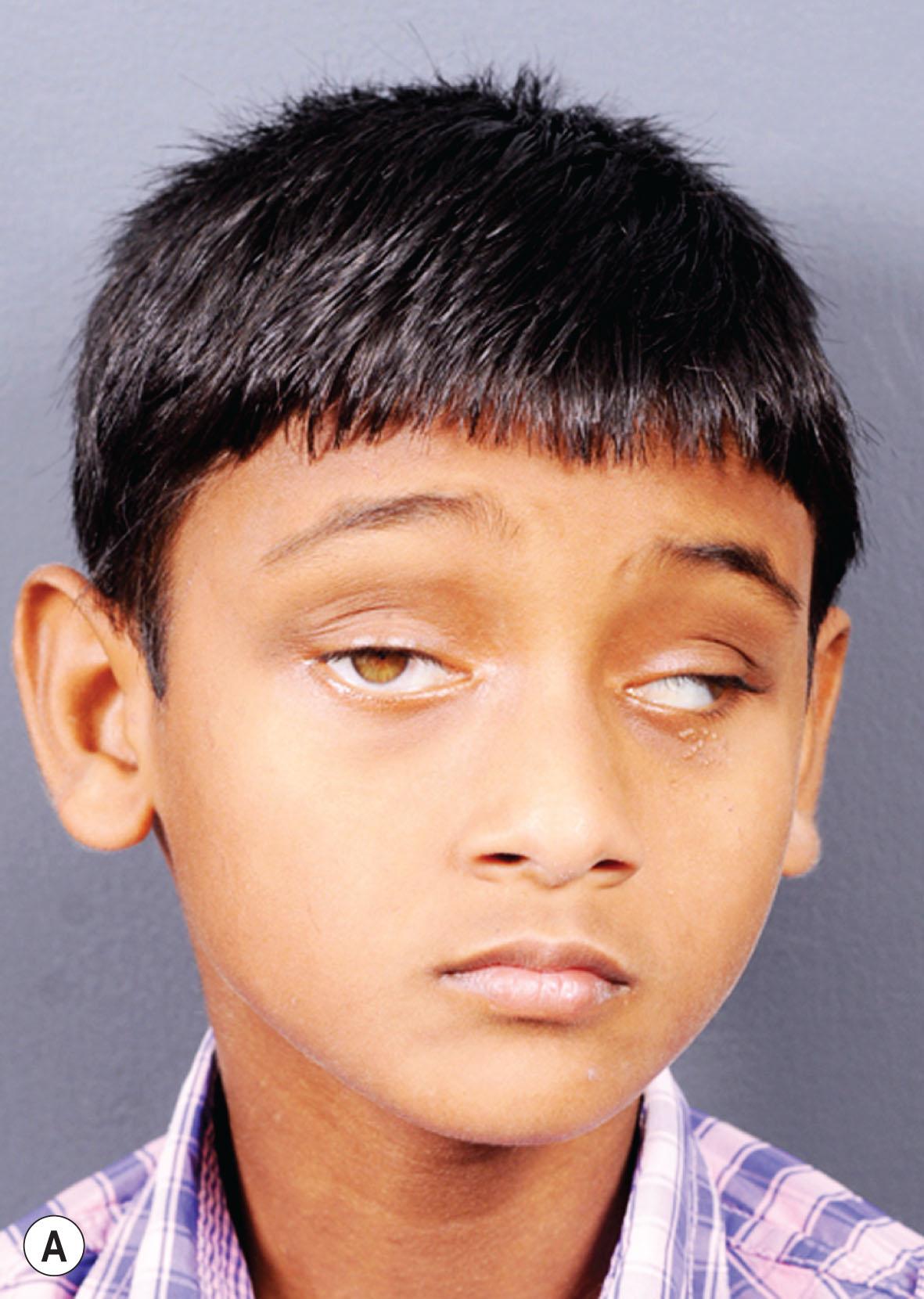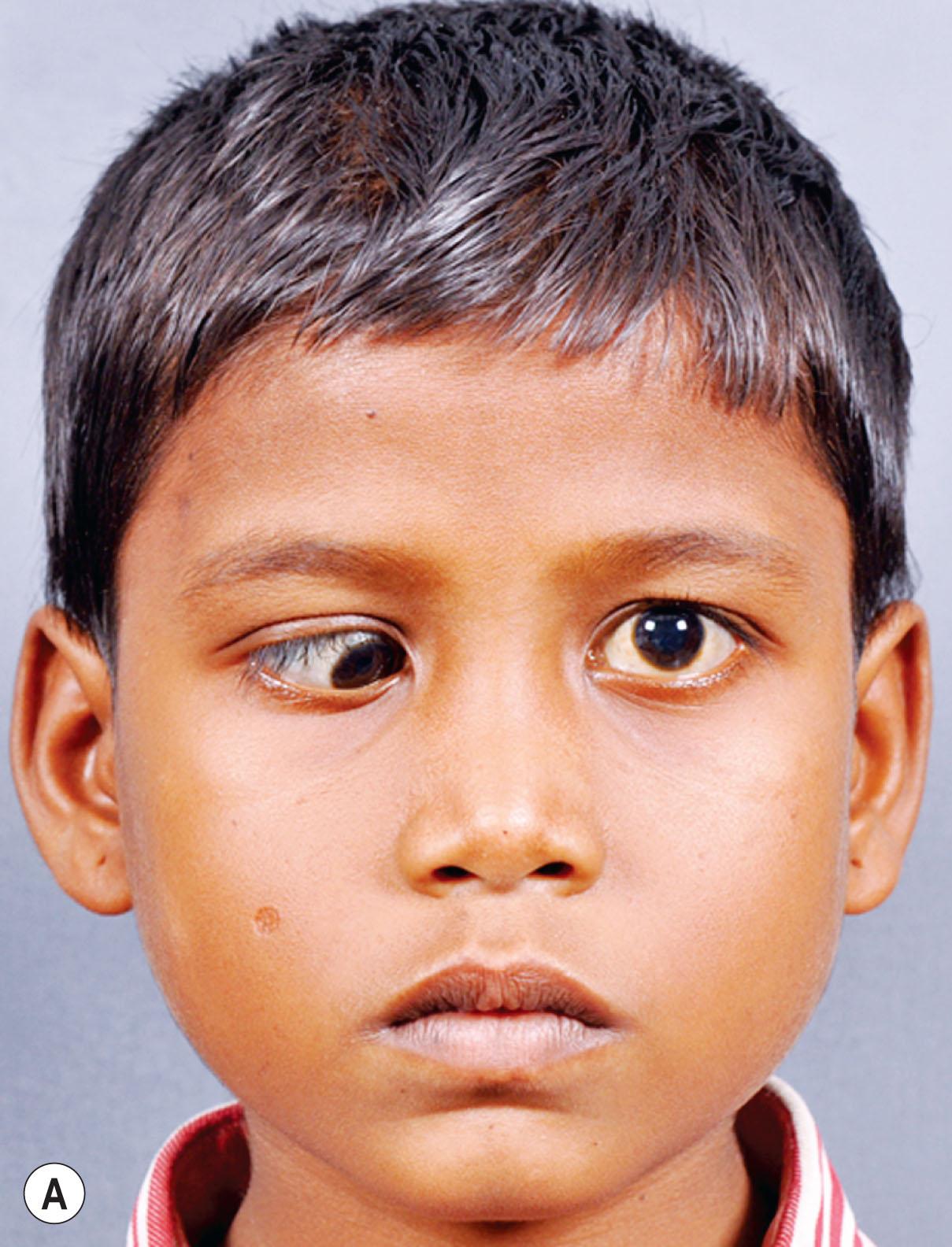Physical Address
304 North Cardinal St.
Dorchester Center, MA 02124
![]() For video accompanying this chapter and supplementary materials see ExpertConsult.com. See inside cover for access details.
For video accompanying this chapter and supplementary materials see ExpertConsult.com. See inside cover for access details.
The term “congenital cranial dysinnervation disorders” (CCDDs) refers to a group of congenital, non-progressive disorders resulting from developmental abnormalities of one or more cranial nerves or their nuclei and primary/secondary dysinnervation. A few common features characterize the patients with CCDDs ( Box 84.1 ).
Onset from birth
Non-progressive
Sporadic or familial
Developmental abnormalities of one or more cranial nerves/nuclei
Dysinnervation:
Primary – due to absence of the nuclei/neurons, or
Secondary – from branches of another nerve during development
They may be sporadic or familial, but most are either proven or suspected to have a genetic basis. Ophthalmologists are frequently consulted about these conditions because of the involvement of the extraocular muscles. Although many of these conditions are characterized only by abnormal extraocular muscle innervation, facial innervation, or both, some have associated systemic and/or neurological abnormalities, such as cerebrovascular, cardiovascular, and skeletal malformations attributable to the underlying genetic defect. At present, at least eight pathogenic genes and ten phenotypes have been identified. To the best of current understanding, the following genes are implicated in these disorders: genes involved in gene transcription (i.e. SALL4 , PHOX2A , HOXA1 , HOXB1 ), microtubule function ( KIF21A , TUBB3 ), and receptor signaling ( CHN1 , ROBO3 ). However, this list is not exclusive and will grow further as our understanding of these diseases increases. These will be discussed in detail in relevant sections.
This chapter focuses on CCDDs characterized wholly or in part by abnormalities of eye movements. These include the three main types of congenital fibrosis of the extraocular muscles (CFEOM), Duane retraction syndrome (DRS), homeobox A1 (HOXA1) spectrum, horizontal gaze palsy with progressive scoliosis (HGPPS), Brown syndrome, congenital trochlear nerve palsy, and Möbius syndrome. For the ease of understanding, these can be subclassified (as shown in Box 84.2 ) into those that affect the vertical eye movements (CFEOM [oculomotor and trochlear nerve]), e.g., Brown syndrome and congenital superior oblique palsy, or the horizontal eye movements (DRS, Möbius syndrome, HGPPS, and HOAX1 spectrum [abducens nerve and supranuclear pathways]).
Fibrosis of the extraocular muscles
Brown syndrome
Congenital ptosis
Congenital trochlear nerve palsy
Duane retraction syndrome
Duane radial ray syndrome
Horizontal gaze palsy with progressive scoliosis (HGPPS)
Congenital facial palsy
Möbius syndrome
This group of disorders is characterized by congenital ocular motility abnormalities due to fibrotic extraocular muscles and congenital ptosis. Most of these patients present first to ophthalmologists because of ptosis or deviation of the eyes. Although previously thought to be secondary to muscle fibrosis (i.e. primary myopathy), clinical and pathological evidence suggests absence of the oculomotor/trochlear/abducens nerve or nuclei (neuropathy). Studies have shown that the diameter of the oculomotor nerves is reduced by 30%–40%. Lim et al. studied the imaging characteristics of subarachnoid portions of oculomotor nerves in 14 patients with CFEOM, 3 with congenital third nerve palsy, and 13 normal subjects. They reported that the diameter of the oculomotor nerve was subnormal on both sides in eight subjects, on at least one side in three subjects, and normal in three subjects with CFEOM in their series.
They also reported that average oculomotor nerve diameter in CFEOM was 1.14 ± 0.61 mm, as compared to 2.01 ± 0.36 mm in normal subjects ( P <0.001). Interestingly, they found a reduction in the diameter of the third cranial nerve in only one patient with bilateral congenital third nerve palsy, and it was normal in the other two patients.
Although three primary CFEOM phenotypes have been described – CFEOM1, CFEOM2, and CFEOM3 (with three subtypes for CFEOM3A, CFEOM3B, and CFEOM3C), the recent literature suggests that at least eight different genetic subtypes of CFEOM have been described with eight genetically defined strabismus syndromes (CFEOM1A, CFEOM1B, CFEOM2, CFEOM3A, CFEOM3B, CFEOM3C, Tukel syndrome, and CFEOM3 with polymicrogyria).
The key features of the important subtypes of CFEOM are briefly discussed below.
CFEOM1 is the classical prototype of the CFEOM phenotypes. Its inheritance is autosomal dominant with full penetrance. It is characterized by bilateral congenital ptosis, bilateral infraducted globes (usually moderate degree), restricted upgaze, variably restricted horizontal gaze, and a compensatory chin-up head posture ( Fig. 84.1 ). These patients have positive forced duction testing and misdirected eye movements such as marked synergistic convergence on attempted upgaze. Neuropathological studies reveal significant atrophy and fibrosis of the superior rectus and levator palpebrae superioris (LPS) muscles, with variable reduction in the size of the other extraocular muscles. Histopathological studies have shown that the oculomotor nerves may be absent or hypoplastic. CFEOM1 shows autosomal dominant inheritance and is caused by a heterozygous missense mutation in KIF21A , chromosome 12 (12q12) 3 that encodes a kinesin microtubule-associated protein associated with anterograde organelle transport in neurons.

A minority of the patients identified as CFEOM type 1B have a TUBB3 mutation.
CFEOM2 is an autosomal recessive disorder characterized by bilateral ptosis, bilaterally absent adduction, upgaze, and downgaze ![]() ( Fig. 84.2A–B ). Although abduction is present, it is limited and the pupils are often irregularly shaped, unequal in size, and non-reactive to both light and near stimulation. These patients might have convergence and pupillary abnormalities. However, other central reflexes (smooth pursuit, saccades, vestibulo-ocular reflex, and optokinetic reflex) in these patients might still be intact. The phenotype resembles diffuse ophthalmoplegia. Neuroimaging shows absence of the third nerves on both sides. This condition is caused by homozygous mutations in the PHOX2A gene located on chromosome 11 (11q13.3–q13.4) 8 that codes for a homeodomain transcription factor expressed predominantly in developing oculomotor and trochlear neurons that is essential for their survival. Mutations alter the factor sufficiently that the oculomotor (and probably trochlear) nerves never develop.
( Fig. 84.2A–B ). Although abduction is present, it is limited and the pupils are often irregularly shaped, unequal in size, and non-reactive to both light and near stimulation. These patients might have convergence and pupillary abnormalities. However, other central reflexes (smooth pursuit, saccades, vestibulo-ocular reflex, and optokinetic reflex) in these patients might still be intact. The phenotype resembles diffuse ophthalmoplegia. Neuroimaging shows absence of the third nerves on both sides. This condition is caused by homozygous mutations in the PHOX2A gene located on chromosome 11 (11q13.3–q13.4) 8 that codes for a homeodomain transcription factor expressed predominantly in developing oculomotor and trochlear neurons that is essential for their survival. Mutations alter the factor sufficiently that the oculomotor (and probably trochlear) nerves never develop.

CFEOM3 is a heterogenous group of disorders that comprise of at least three genetically different disorders (CFEOM3A, CFEOM3B, CFEOM3C). These are inherited in an autosomal dominant manner and have an ocular motility pattern that resembles an oculomotor nerve palsy. These therefore resemble patients with CFEOM1 except that their findings are more variable, and they sometimes retain the ability to elevate the eyes above the horizontal ![]() ( Fig. 84.3A–B ). The phenotypic variability results at least partly from heterozygous mutations in at least two genes: TUBB3 or TUBB2A (CFEOM3A; MIM #600638), KIF21A (CFEOM3B), and co-segregation of CFEOM3 w/a translocation in CFEOM.
( Fig. 84.3A–B ). The phenotypic variability results at least partly from heterozygous mutations in at least two genes: TUBB3 or TUBB2A (CFEOM3A; MIM #600638), KIF21A (CFEOM3B), and co-segregation of CFEOM3 w/a translocation in CFEOM.

In addition, several missense mutations may occur in the TUBB3 gene, which codes for a component of microtubules. Thus, some patients with CFEOM3A have isolated ocular motor deficits (some even have isolated absence of upgaze), whereas others have bilateral facial weakness, peripheral sensory or sensorimotor neuropathies, wrist and finger contractures, cognitive dysfunction, or a combination of these features. Magnetic resonance imaging (MRI) may show dysgenesis of the corpus callosum and anterior commissure in some cases. Patients have been described who have a phenotype similar to CFEOM1, except for the presence of some upgaze, and who have a mutation in KIF21A . They are said to have CFEOM3B. A single family has been described in which three generations have what appears to be CFEOM3 but who carry a reciprocal translocation involving chromosomes 2q and 13q, termed CFEOM3C (MIM #609384). Patients with CFEOM type 3 might have associated other features such as intellectual disability, social disability, facial weakness, vocal cord paralysis, and Kallmann syndrome (see Box 84.3 ).
Non-progressive congenital ophthalmoplegia in one or both eyes
Might have non-progressive congenital ptosis in most types
Poor binocularity, refractive errors and common to have amblyopia in all subtypes
Unilateral involvement: type 3 or Tukel syndrome
Autosomal dominant pattern: CFEOM type 1 A, type 1B, CFEOM type 3, CFEOM type 3 with polymicrogyria
Autosomal recessive pattern: CFEOM type 2 and Tukel syndrome
Pupillary involvement: CFEOM type 2
Absence of ptosis, “preserved upgaze” movement: CFEOM type 3 or Tukel syndrome
Associated oligodactyly or oligosyndactyly: Tukel syndrome
Associated synkinesis: CFEOM type 1 or CFEOM type 3 with polymicrogyria
Retinal dysfunction: CFEOM type 2
Intellectual and social disability, facial weakness, vocal cord paralysis, Kallmann syndrome, cyclic vomiting, spasticity: CEFOM type 3
Kallmann syndrome (hypogonadotropic hypogonadism with anosmia): CFEOM type 3
Intellectual disability, social disability, vocal cord paralysis, polymicrogyria, microcephaly: CFEOM type 3 with polymicrogyria
Primary vertical position: usually infraducted in all except normal or slightly above midline in type 2/ type 3
Primary horizontal deviation: variable but CFEOM type 2 usually show exotropia
These patients have CFEOM type 3-like features along with post-axial oligodactyly or oligosyndactyly of the hands. These patients may have unilateral or bilateral affection having a dysmotility in the distribution of oculomotor nerve palsy. Inheritance is usually autosomal recessive.
These patients have a CFEOM type I-like features but also have intellectual disability, polymicrogyria, and microcephaly. This disorder is also inherited in an autosomal dominant manner and occurs due to mutations in TUBB2B gene.
The management of CFEOM patients is challenging as there is a problem of dysinnervation of multiple muscles, often associated with large angle deviation, ptosis, and abnormal head posture. They may have complex ocular motor deficits and ptosis, but also systemic and/or neurological deficits. Even though the outlook is guarded, some options may be helpful:
A study of 40 patients with CFEOM by Chen et al. reported an incidence of amblyopia of about 95%. In addition, they found that 85% of the patients had astigmatism, and 11.7% had simple hyperopia. Thus, all patients with CFEOM should undergo a cycloplegic refraction, part-time occlusion therapy or atropine penalization as appropriate (see Chapter 74 ). Regular follow-up is advised throughout their period of visual development.
Become a Clinical Tree membership for Full access and enjoy Unlimited articles
If you are a member. Log in here